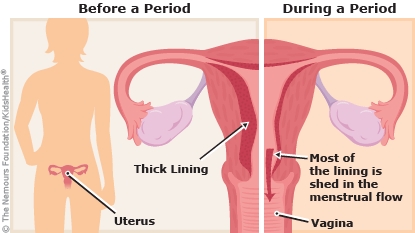Preparing Your Child for Her Menstrual Cycle
The menstrual cycle is a normal part of growing up. Your daughter may be excited and/or worried about starting her period.


Most girls begin puberty between the ages of 9 and 12. The body changes as it transitions into womanhood. Hormones stimulate bone growth and the development of breasts and pubic hair. A girl usually gets her first period about 2 years after her breasts begin to develop.
In a normal menstrual cycle, rising levels of the hormone estrogen cause the uterus to grow a thicker lining of blood and tissue. At the same time, an egg begins to mature in the ovary. Around day 14 of a 28-day cycle, ovulation occurs and the egg is released. The egg travels through the fallopian tube toward the uterus. Rising hormone levels prepare the uterus for a possible pregnancy, but if the egg is not fertilized, hormone levels drop and the lining of the uterus is shed.
Many girls undergo physical and emotional changes during their periods. A girl's cycle is counted from the first day of bleeding in one month to the first day of bleeding in the next month. Normal cycles can range from 21 to 45 days.
The menstrual cycle is often irregular during the first 2 years after periods begin. Dancers and athletes may have their first period later than other girls.

-
Make sure your daughter eats plenty of healthy food to support normal pubertal development and menstrual cycles.
-
Help your daughter track her periods on a calendar, writing down when the periods start and end, as well as how heavy they are.
-
Reassure your daughter. It may look like a lot of blood, but is usually only a few tablespoons.
-
Keep a supply of pads and tampons on hand and teach your daughter how to use them.
-
Make sure your daughter changes tampons frequently to prevent a rare infection called toxic shock syndrome.

-
Your daughter reaches age 13 without having breast development or a period.
-
Your daughter has breast development but no period by age 15 or has breast development for 4 years without having a period.
-
Your daughter needs more than one sanitary pad or tampon per hour.
-
Bleeding lasts more than 10 days or there are fewer than 20 days between periods.
-
Periods continue to be or become irregular 2 years after your daughter had her first period.

-
Your daughter is having her period and develops a sudden fever, muscle aches, diarrhea, vomiting, dizziness, fainting, sunburn-like rash, sore throat, and/or bloodshot eyes.